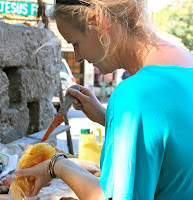Two wonderful things I came home with from Kenya-
One was a very groovy dance number- Nwa Baby by Nigerian hiphopper- Flavour
The other was this very wonderful kitchen tool called a mbuzi (which also means goat in Swahili), to which I promised to dedicate a post.
It is an ingenious gadget, a seat and coconut grater in one- who could think of such a thing?
At the risk of looking (very) foolish I decided to have documented my attempts to use it. It looked simple enough, it was demonstrated to me by its seller and I’ve also seem a picture or two, but in reality it takes a lot of skill, just the right swirl of the coconut and just the right pressure so one just grates the soft white fruit and not the brown shell… I have to get a lesson, pointers anyone?
The grated fresh coconut was so succulent, I wanted to eat it right there from the bowl, but excercised restraint, to use it in a pimped version of wali wa nazi- coconut rice laced with pieces of ripe mango, chilli, mint, fresh coriander, lime zest and juice, toasted peanuts and crisply fried onions, all in a delicious salad. We had it with roast chicken.
Wali wa nazi with mango
300 g basmati rice
1 teaspoon salt
400 ml thin coconut milk
1 red chilli, finely sliced
2 red onions, chopped
1 small bunch of fresh mint leaves, chopped
1 small bunch of fresh coriander leaves, chopped
grated zest and juice of 1 lime
6 tablespoons sunflower oil
3 shallots or small onions, thinly sliced
1 teaspoon sugar
1 large ripe mango, peeled and flesh cut into 1 cm cubes
100 g (10 tablespoons) fresh grated coconut
3 tablespoons toasted peanuts, chopped
Method: Preheat the oven to 200°C. Put the rice in an ovenproof saucepan with the salt, coconut milk and 300 ml water and bring to the boil. Simmer for 10 minutes, stirring, then place in the oven for another 20 minutes. Scoop into a colander and allow to cool. Mix the chilli, onions, fresh herbs, lime zest and juice with 2 tablespoons of the oil. Meanwhile heat the remaining oil and fry the shallot slices with the sugar to a crisp golden brown over a medium heat. Drain on a piece of paper towel. Mix the rice into the dressing and gently mix in the coconut, peanuts and mango cubes. Season to taste with salt and pepper. Sprinkle with the fried onions and serve.
Serves 4


















